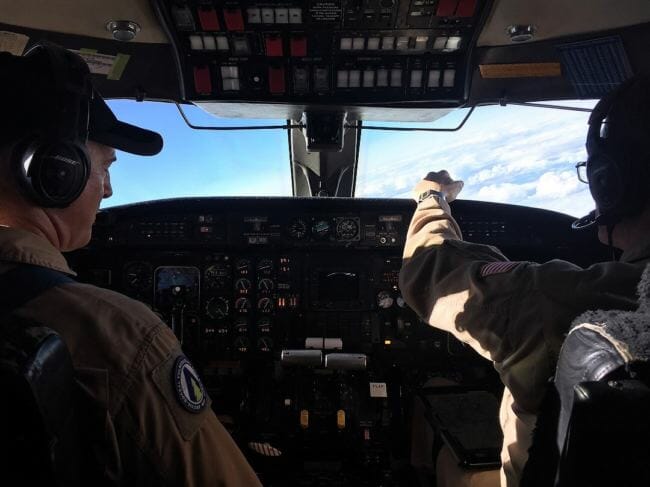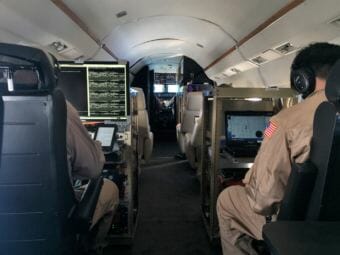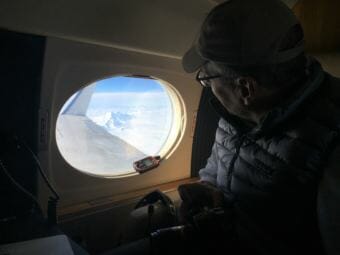
The National Aeronautics and Space Administration (NASA) is best known for its exploration of the world beyond our planet. But on a recent NASA science flight over Interior Alaska the plane never left earth’s orbit and the thing being studied was the ground. It’s part of project called the Arctic-Boreal Vulnerability Experiment (ABoVE) that NASA is leading to look at environmental changes in Alaska and northwest Canada, many of them driven by climate change.
At Eielson Air Force Base, the spot where the plane takes off from, it’s spitting rain as the six-person NASA team files onto a small business jet.
If you’d expect a NASA science plane to be all polished steel and shiny computer screens, you’d be wrong. There are some metal racks with monitoring equipment mounted on them, but this plane was built in 1983 and looks it: there’s old wood paneling and beige leather seats with brass seat belts.
“It’s a former air force plane… it used to fly generals around and NASA got it as a government surplus,” said Peter Griffith, an earth scientist with NASA. His colleagues refer to him with a chuckle as the “S.O.B” or “scientist on board.”

So, what science is being done on board this airplane?
It has to do with a piece of equipment we can’t see from inside. A super fancy radar stuck to the bottom of the plane that jumps into action once we’re up at 41,000 feet.
“So the radar is now shooting off the left wing of the plane. It’s picking up the vegetation structure, it’s picking up the ground surface, and it’s picking up a little bit of information about how much soil moisture is in the top of the soil,” Griffith explained.
That information — whether there’s forest, shrub or tundra below us, whether the ground is rising or sinking, and what the soil moisture is — will help NASA answer a larger question.
“The information that we’re getting on this flight will help us understand on a much broader scale how permafrost thaw is occurring across this area,” Griffith said.
Permafrost isn’t the only thing that the ABoVE campaign is studying. There’s a whole host of environmental changes the project is examining, like the severity and frequency of forest fires, insect activity and wildlife migration.
NASA’s big strength is collecting information from way above the earth, which lets them look at a huge area. The ABoVE domain is 2.5 million square miles.
But they’re also partnering with dozens of institutions to conduct research on the ground that ties into what they’re collecting from the air. The University of Alaska Fairbanks is one of their partners, as is the Alaska Department of Fish and Game, the National Park Service and the Department of Energy among many others. Griffith shows me a slide on his computer with the full list.
“When I put this slide together we had 379 U.S. science team members,” he said.

That’s not counting additional collaborators in Canada.
At the end of this flight campaign, NASA and their partners will have a ton of data about how things are changing in a huge swath of the north.
But they’re not going to conduct these flights forever; they’re expensive. So another goal of the project is to refine some of the technology they’re using so it can be mounted on satellites.
That way, NASA can monitor these changes on a regular basis going forward.
